On This Page
The Best CPAP Masks of 2025
Our Top Picks
-
Best Overall
ResMed AirTouch F20 Full Face CPAP Mask with Headgear -
Best for New CPAP Users
ResMed AirFit N30i Starter Pack -
Best for Side Sleepers
ResMed AirFit P10 Nasal Pillow CPAP Mask -
Best for Combination Sleepers
Philips Respironics DreamWear Full Face CPAP Mask -
Best for People Who Wear Glasses
ResMed AirFit F30 Full Face CPAP Mask -
Best for Women
ResMed AirFit N20 for Her Nasal CPAP Mask
Best Overall
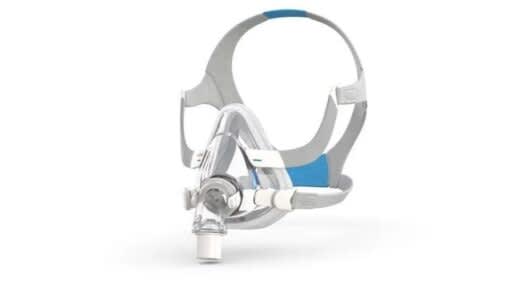
The ResMed AirTouch F20 is a full-face mask that comfortably fits a wide range of sleepers. Many CPAP masks use silicone cushions, but the AirTouch F20 uses memory foam, creating a soft and comfortable cushion that seals effectively while conforming to the shape of your face.
Pros & Cons
Pros
- Memory foam mask cushion feels soft but seals strong
- Three mask sizes to choose from
- Magnetic clips and quick-release elbow make it easy to put on and take off
Cons
- Potentially not suitable for people with pacemakers, insulin pumps, and other metal implants
- May be uncomfortable for sleepers with facial hair
Full Details
Best for New CPAP Users
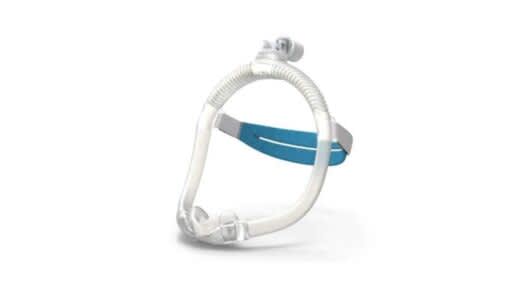
Many people just starting CPAP therapy worry that they won’t be able to find a comfortable mask. For anyone new to CPAP, the ResMed AirFit N30i Starter Pack is an excellent option that offers three cushion sizes to test out at home and find the right fit.
Pros & Cons
Pros
- Comes with small, medium, and small wide cushions
- Compact and lightweight design
- Freedom of movement with top-of-head hose connection
Cons
- People who require high CPAP pressure levels may need a full-face mask
- Not ideal for those who primarily breathe through their mouths
Full Details
Best for Side Sleepers
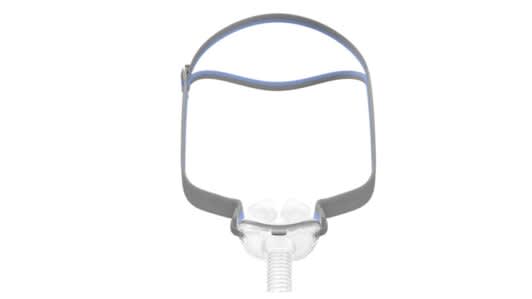
With a super lightweight and compact design, the ResMed AirFit P10 Nasal Pillow Mask is one of the most comfortable options for people who sleep on their side.
Pros & Cons
Pros
- Sleek design
- Includes three mask cushion sizes to try at home
- Features quiet venting technology
Cons
- Those who use higher CPAP pressure settings may need a full-face mask
- Nasal irritation may occur
Full Details
Best for Combination Sleepers
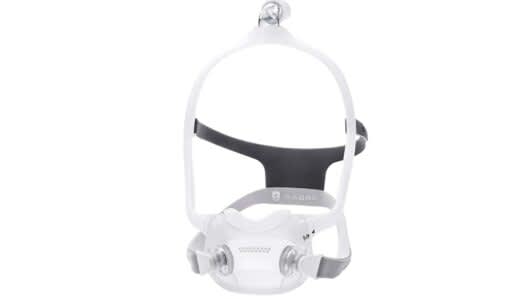
The Philips Respironics DreamWear Full Face Mask has a low profile and a customizable fit that creates a strong seal in any sleep position.
Pros & Cons
Pros
- Four adjustment points keep the mask sealed and in place
- Low-profile, non-claustrophobic full-face design
- Top-of-head attachment keeps the hosing out of the way
Cons
- May be too much for people who need lower CPAP pressure levels
- Some users may notice nostril irritation
Full Details
Best for People Who Wear Glasses
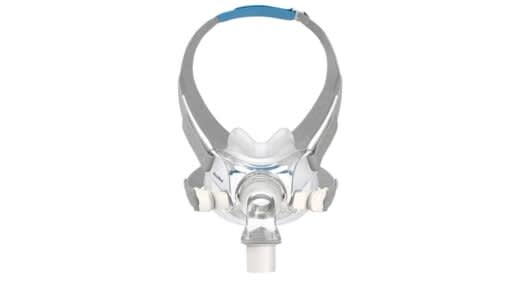
The ResMed AirFit F30 Full Face Mask is lighter and less obtrusive than traditional full-face mask designs, providing a clear line of sight that allows you to comfortably wear glasses. Its quiet elbow and venting also create fewer disruptions as you sleep, read, or watch TV.
Pros & Cons
Pros
- Low-profile full-face design
- Ultra soft headgear
- Secure seal reduces pressure points
Cons
- May not be comfortable for side sleeping
- People with beards may notice irritation
Full Details
Best for Women
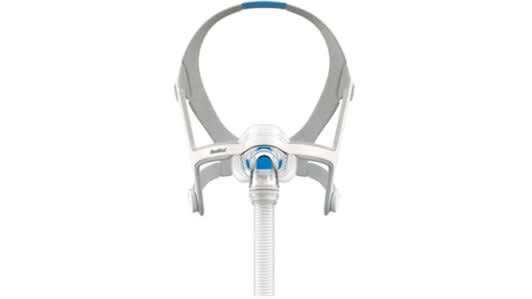
Featuring headgear that's sized down to accommodate smaller heads, the ResMed AirFit N20 For Her Nasal Mask is designed to work well for anyone with a smaller facial structure. You can also choose from small, medium, or large cushion sizes to further customize the fit.
Pros & Cons
Pros
- InfinitySeal technology helps keep seal in place
- Padded frame and soft headgear for extra comfort
- Designed to be easy to put on and take off
Cons
- Those with larger facial structures may need a wider mask
- Magnetic clips can cause health problems for people with pacemakers and other metal implants
Full Details
How We Make Our Picks
Every model we feature must impress our team of experts to appear on our list of the best CPAP masks. Dr. Breus, our product researchers, and the medical professionals at Sleep Doctor stay informed and up-to-date by studying peer-reviewed articles and analyzing products.
To decide which CPAP masks are better than the competition, we consider verified reviews, taking face shape and size, sleeping position, and facial hair into account. Our research team regularly checks for updates regarding product recalls and machine compatibility.
Types of CPAP Masks
CPAP masks come in a few different styles. Each masks type is best-suited to different people based on their breathing patterns, comfort preferences, and pressure needs.
Nasal Pillow CPAP Masks
Nasal pillow CPAP masks feature a compact cushion that sits just below the nose and creates a seal around the nostrils. The mask cushion is usually made out of silicone or a gel material.
This CPAP mask type is lightweight and has a minimal facial footprint, making it a suitable style for many side and stomach sleepers. However, people who require higher CPAP pressure settings may find the concentrated airflow of nasal pillows uncomfortable.
Who’s a Good Fit
- People who need low to moderate CPAP pressure settings
- Sleepers with facial hair
- Those who frequently toss and turn in their sleep
Who Should Keep Searching
- People who need higher pressure settings
- Those prone to nasal dryness
- Sleepers who breathe through their mouth
Nasal CPAP Masks
Nasal CPAP masks consist of a cushioned frame that sits over the nose from the nasal bridge to the area above the lip. The frame cushion can be silicone, memory foam, or a gel material. This style of mask comes in a wide range of shapes and sizes and is a good compromise between the bulkier profile of a full-face mask and the minimal design of a nasal pillow mask.
Who’s a Good Fit
- People with higher pressure needs who find nasal pillows uncomfortable
- Those who dislike the bulkier fit of full-face masks
- Active sleepers
Who Should Keep Searching
- People who breathe through their mouth
- People with allergies or frequent nasal blockages
- Stomach sleepers
Full-Face CPAP Masks
Full-face (oronasal) CPAP masks have a cushioned frame that covers both the nose and the mouth. Although less common, a full-face mask may also refer to CPAP masks that cover the entire face. This type of mask is typically the best choice for people who breathe primarily through their mouth during sleep.
Who’s a Good Fit
- Sleepers who tend to breathe through their mouth
- People who require high CPAP pressure settings
- Back sleepers
Who Should Keep Searching
- People who sleep on their stomach
- Active sleepers who frequently change positions
- Those with thick beards
How to Find the Best CPAP Mask for You
With so many styles and models to choose from, it can be hard to find the best CPAP mask for your needs. While it may take some trial and error, you can start to narrow down the selection by considering your budget, sleep position, and comfort preferences.
Price and Size
Like CPAP machines, CPAP masks come in a range of price points. In general, CPAP masks can cost anywhere from $20 to over $100, depending on the style, materials, and features.
CPAP masks also come in a range of sizes so that most people can find one that fits their face. Keep in mind that CPAP mask sizes are not standardized, and sizes differ between manufacturers.
To find the right size, use the sizing guide from the manufacturer for the specific mask model that interests you. CPAP mask product pages typically include a link to instructions for finding your size.
Sleep Position
- Back sleepers have the most flexibility in choosing a CPAP mask style, with nasal masks, nasal pillows, and full-face masks all being viable options depending on comfort preferences and pressure requirements.
- Side sleepers may find the bulkier design of full-face masks uncomfortable and typically prefer the smaller profile of nasal masks or nasal pillows.
- Stomach sleepers tend to be more limited in their choices, with the minimalist design of nasal pillows often being the only comfortable option for the position.
Pressure Settings
A person’s prescribed CPAP pressure setting can also impact comfort and therapy adherence. While full-face and nasal masks are more compatible with higher pressure levels, the direct airflow of nasal pillows can be uncomfortable for some users at a high pressure setting and may cause increased nasal irritation and congestion. Using a CPAP humidifier may reduce the likelihood of these side effects.
Feel and Comfort
The best CPAP mask is the one that feels comfortable and allows you to get the full benefits of CPAP therapy on a nightly basis. While some CPAP users enjoy the minimal design of nasal pillow masks, others prefer the indirect airflow of nasal or full-face masks.
If possible, try a variety of models and styles and discuss any comfort issues with your doctor or sleep specialist. They can help you solve common problems like improper fit, air leaks, dry mouth or nasal passages, and getting used to the sensation of pressure.
Device Compatibility
Make sure that any CPAP mask you purchase is compatible with your CPAP machine. Most CPAP masks on the market are universally compatible with all CPAP machines, but there are a few exceptions to this rule. It’s always a good idea to double-check compatibility before you buy.
Materials
The materials that your mask is made from can impact both durability and comfort. Many CPAP masks consist of a plastic frame with a pliable silicone cushion and one or more elastic straps to hold the mask in place. You can also find CPAP masks that use memory foam or inflatable cushions.
If you often fall asleep while reading or watching TV, you might want to consider a mask that sits outside of your field of vision. Nasal pillows and certain full-face masks can be worthwhile options.
CPAP Mask Accessories
CPAP masks generally come with a cushion, headgear, and a short length of tubing. These components are necessary for CPAP therapy, and you’ll need to replace them periodically.
Other accessories are optional but can improve the comfort of your CPAP experience. These include items like mask liners, chin straps, and CPAP pillows. Before purchasing any CPAP accessories, be sure to check that they’re compatible with your existing equipment.
|
Accessories
|
Description
|
|
Cushions and Headgear |
A CPAP cushion is the soft, pliable mask component that rests against your face. Headgear consists of the straps that wrap around your head. These essential components wear out over time and require occasional replacement. |
|
Hosing |
Hosing is an essential component that connects your mask to your CPAP machine. Most CPAP masks come with a short length of tubing, but you may need to buy a longer segment if you want more freedom of movement. |
|
Mask Liners |
Mask liners wrap around the cushion of your CPAP mask. This accessory is not essential but can help reduce skin irritation and mask leaks. Liners may also prolong the life of your mask cushion. |
|
Chin straps |
A CPAP chin strap is a circular band of stretchy material that wraps around the base of your chin and the top of your head. While not essential, it can help keep your mouth closed and encourage nasal breathing to potentially prevent air leaks and dry mouth. |
|
CPAP Pillows |
CPAP pillows are an optional accessory that may make it easier to sleep with your CPAP mask. These specially designed pillows usually feature a cutout so that you can sleep on your side without dislodging your CPAP mask. |
How to Get a CPAP Mask
While CPAP therapy can be an expensive process, essential equipment may be eligible for insurance coverage.
Do You Need a Prescription for a CPAP Mask?
You need a prescription to purchase a CPAP mask. The U.S. Food and Drug Administration (FDA) classifies CPAP systems, including CPAP masks, as Class II medical devices. This helps the FDA ensure CPAP masks are safe and effective, but it also means you’ll need a prescription from your doctor to buy one.
Does Insurance or Medicare Cover CPAP Masks?
Most insurance plans, including Medicare, cover part of the cost of a CPAP mask. Medicare typically covers an initial three-month trial of CPAP therapy. If your doctor determines that CPAP helps improve your symptoms, Medicare may extend your coverage for a CPAP device and accessories like a CPAP mask.
For private insurance, the level of coverage depends on your plan, so be sure to check with your insurance company first. If you purchase your CPAP mask from a third-party retailer, you may need to submit a claim form for reimbursement.
Where Can You Buy a CPAP Mask?
CPAP masks are available to buy online or in person from authorized retailers. They can also be purchased directly from a sleep clinic or doctor’s office.
Sleep Doctor also offers a wide range of high-quality CPAP masks from leading brands, along with expert guidance to help you find the best fit. When you purchase through Sleep Doctor, you get access to reliable customer support and fast shipping, making it easy to replace your mask or try a new style as your needs change.
How to Clean a CPAP Mask
Your CPAP mask comes into close contact with your face each night. As a result, it’s important to keep your CPAP mask clean. After each use, wipe down the mask cushion or nasal pillow and other areas that contact your skin with a damp cloth or a CPAP wipe.
Once a week, give your CPAP mask a more thorough cleaning. To wash your CPAP mask, you’ll need:
- A sink or tub
- Warm water
- Mild soap
Instructions
- Disconnect your CPAP mask from the machine and tubing.
- Fill a tub or sink with warm, soapy water. Avoid harsh cleaning agents like bleach or rubbing alcohol, which may damage your CPAP mask and can be harmful to breathe.
- Gently wash the mask, then rinse with warm water.
- Leave your mask out to air dry.
You should also wash your CPAP tubing, headgear, and mask cushion or nasal pillow on a weekly basis using the same method.
These are general guidelines, but it’s always a good idea to consult the manufacturer for cleaning tips. You may also want to keep a second mask on hand to use while the other dries.
Frequently Asked Questions
How do you put on a CPAP mask?
To put on your CPAP mask, first sit upright on the edge of your bed. Loosen the headgear straps and place the mask over your head and face. Next, lie down in bed as you would if you were going to sleep.
Begin gently tightening the straps of your mask until they feel comfortably fitted but not too tight. Make sure the hose is connected properly to the CPAP machine and your mask. Turn on the machine and lie back down. Check for any air leaks and make final adjustments as needed.
How often should you replace your CPAP mask?
In general, you should replace your CPAP mask cushion or nasal pillow once a month, the frame and tubing every three months, and the headgear every six months.
Check for specific information about replacement schedules from your mask’s manufacturer. Regular replacement of mask components is important to keep your CPAP mask sanitary and functioning properly.
How do you wear your hair with a CPAP mask?
People with long hair can try wearing it in a loose ponytail or braid, or wrapped in a scarf or other head covering. This should help avoid matting, slipping, or tangling with the CPAP mask straps.
